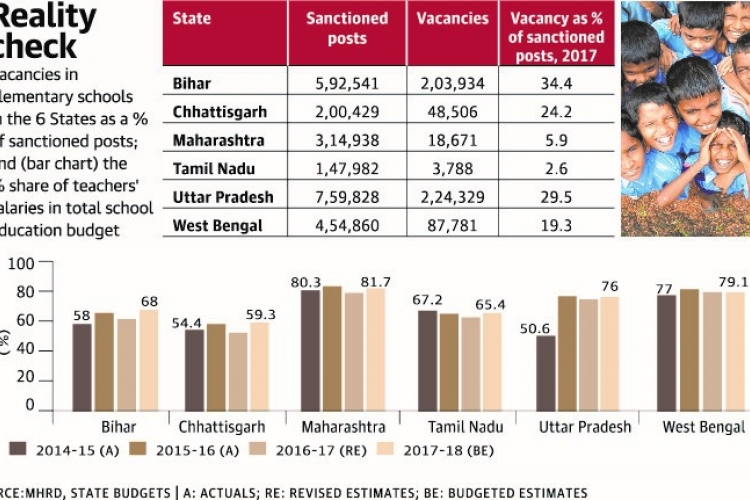Hard lesson: funds not enough to attract teachers to government schools
State governments have increased their budgets for school education in the past three years, but the allotment of funds has not been enough to attract permanent qualified teaching staff to government schools, finds a recent study conducted across six States.
The report, prepared jointly by Child Rights and You (CRY) and the Centre for Budget and Governance Accountability (CBGA), examines budgeting for school education in six States — West Bengal, Chhattisgarh, Tamil Nadu, Uttar Pradesh, Bihar and Maharashtra — during the 14th Finance Commission recommendation period, which started in April 2015.
The study finds that there has been an overall increase in revenue with the States following the 14th Finance Commission recommendations. This was a result of an increase in the share of the States in the divisible pool of Central taxes from 32% to 42%. At the same time, a reduction in the Union government’s contribution to the States for Central schemes in social sectors forced the States to improve their tax revenue collection. The study analyses whether the availability of additional funds translated into prioritising of school education in these six States.
Between 2015-16 and 2017-18, there was a net decline in the share of school education budget in the total State Budget for three of the six States, according to the detailed demand for Grants and State Budget documents. Bihar saw a dip of 3.1%, Maharashtra a drop of 1% and West Bengal 0.9%. On the other hand, Chhattisgarh, Tamil Nadu and Uttar Pradesh saw an increase in the size of school education budget by 0.4%, 2.6% and 3.2%, respectively.
The report examines whether the increase in the size of school education budget was more than the rise in size of the total budget, indicating a higher priority for the sector. It concluded that between 2014-15 and 2017-18, Uttar Pradesh saw a 98.8% increase in budget for schools, whereas its total budget increased by 63.3%. West Bengal’s budget for school education increased by 49.4% while its total budget increased by 48.2% and in Tamil Nadu, the former increased by 38.7% but the total budget increased by 38.5%, indicating that school education was a priority for these three States.
At the same time, all the six States showed an increase in the magnitude of per-child and per-student spending for education between 2014-15 and 2016-17.
Despite a varying level of commitment towards school education across the six States, all of them struggle with a shortage of teachers. The report cites data from the Union Ministry of Human Resource Development to show that as on March 2017, West Bengal, Chhattisgarh, Uttar Pradesh and Bihar have from 19% to 34% of total teacher positions at the elementary level vacant. Maharashtra and Tamil Nadu were relatively better with 5.9% and 2.6% posts unfilled.
Data from the District Information System for Education show that at the upper primary level, there is a severe paucity of subject-specific teachers required under the Right to Education Act — 77% upper primary schools in Maharashtra, 46% in Uttar Pradesh, 40% in West Bengal and 37% in Bihar do not have subject teachers.
Single teacher
More than one lakh schools in India are run with only one teacher and all the six States surveyed have shown the number of such schools on the rise. The shortage of teachers is more acute at the secondary level — Bihar has 20,494 teaching posts vacant, Chhattisgarh 8,278 and Uttar Pradesh 12,008.
The figures don’t entirely capture the severity of the shortfall as they do not reflect the shortage of subject teachers.


 IAS -2025 Prelims Combined Mains Batch - III Starts - 14-04-2024
IAS -2025 Prelims Combined Mains Batch - III Starts - 14-04-2024